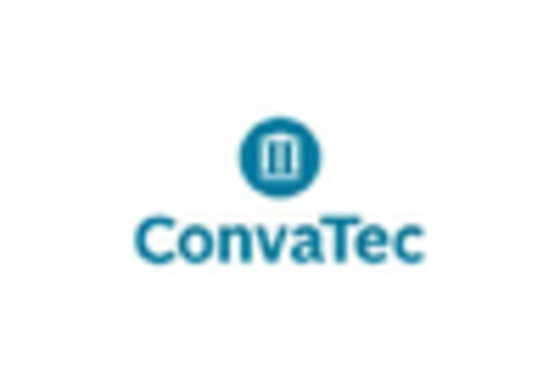Growing Awareness of Wound Care
The rising awareness regarding effective wound care practices is a crucial driver for the Foam Dressing Market. Educational initiatives and campaigns aimed at both healthcare professionals and patients are fostering a better understanding of wound management. This increased awareness is leading to a higher adoption rate of advanced wound care products, including foam dressings. As patients and caregivers become more informed about the benefits of using foam dressings, such as their ability to maintain a moist wound environment and promote faster healing, the demand for these products is expected to grow. The Foam Dressing Market stands to benefit from this trend, as more individuals seek out effective solutions for wound care.
Rising Incidence of Chronic Wounds
The increasing prevalence of chronic wounds, such as diabetic ulcers and pressure sores, is a notable driver for the Foam Dressing Market. As the global population ages, the incidence of conditions that lead to chronic wounds is expected to rise. According to recent estimates, chronic wounds affect millions of individuals worldwide, necessitating effective treatment solutions. Foam dressings, known for their superior absorbency and comfort, are becoming a preferred choice among healthcare providers. This trend is likely to propel the demand for foam dressings, as they provide optimal healing environments and reduce the risk of infection. The Foam Dressing Market is thus positioned to experience growth as healthcare systems adapt to the increasing burden of chronic wound management.
Expansion of Healthcare Infrastructure
The expansion of healthcare infrastructure in various regions is contributing to the growth of the Foam Dressing Market. As healthcare facilities increase in number and capacity, there is a corresponding rise in the demand for advanced wound care products. New hospitals and clinics are being equipped with modern medical supplies, including foam dressings, to ensure optimal patient care. This expansion is particularly evident in emerging markets, where investments in healthcare are on the rise. The Foam Dressing Market is likely to see increased sales as healthcare providers seek to stock their facilities with effective wound management solutions. This trend suggests a positive outlook for the market as healthcare systems evolve.
Shift Towards Home Healthcare Solutions
The shift towards home healthcare solutions is reshaping the Foam Dressing Market. As more patients receive care in their homes, the demand for user-friendly and effective wound care products is increasing. Foam dressings, which are easy to apply and remove, are becoming a preferred choice for home care settings. This trend is driven by the desire for cost-effective healthcare solutions and the convenience of at-home treatment. As the population ages and the prevalence of chronic conditions rises, the need for effective home healthcare products, including foam dressings, is likely to grow. The Foam Dressing Market is poised to capitalize on this shift, as it aligns with the broader movement towards patient-centered care.
Technological Innovations in Foam Dressings
Technological advancements in the development of foam dressings are significantly influencing the Foam Dressing Market. Innovations such as the incorporation of antimicrobial agents and advanced moisture management systems enhance the efficacy of foam dressings. These innovations not only improve patient outcomes but also reduce the overall cost of wound care. The market has seen a surge in products that offer enhanced features, such as increased wear time and better conformability to various wound types. As healthcare providers seek to adopt the latest technologies to improve patient care, the demand for advanced foam dressings is likely to rise. This trend indicates a robust growth trajectory for the Foam Dressing Market, driven by continuous product development and innovation.


















Leave a Comment